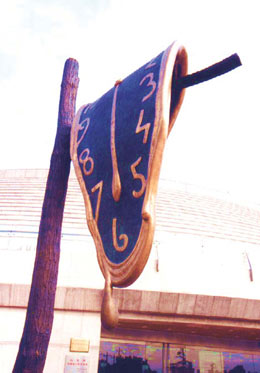| A Tale of Two Museums |
| http://www.sina.com.cn 2005/04/26 19:12 thats China |
Chen says that in the Age of the Internet, "perhaps hundreds or thousands of people explore a museum's website for every one person who visits the museum itself," and adds she has been prodding MAM to quickly improve its presence in cyberspace. The Millennium Art Museum currently hosts only rudimentary sites (www.mam.gov.cn in Chinese and www.bj2000.org.cn in English) that do not even have cross-links or info on upcoming exhibitions. The Web-savvy Chen says her personal favorite museum website, operated by the Netherlands Witte de With Center for Contemporary Art at www.wdw.nl, "is extremely interactive and shows how successful a virtual museum could become." Synchronized with its top exhibits, the Rotterdam museum operates public and online dialogues that invite the world to take part. Throughout 2004, the Witte de With Center brought together a group of Western and Islamic scholars and artists to hold a running on-site and online discourse on the causes of and potential solutions to terrorism and war in the Middle East. Chen says "the entire Witte de With museum has been digitalized and entered the virtual world." Zhu Jun, chief technical supervisor at the Millennium Art Museum, says, "Many of China's leading museums have started creating digital versions of their collections or designing websites as part of China's 'digital museum project.'" Zhu says the project has three aims: to create a digital library of each museum's collection, to utilize digital technology to help preserve or restore artworks, and to post some collections on the Web. But art industry insiders say that government funding has been tight for the digital museum project, which in turn has slowed down the building of websites or digitalized collections. "We are just starting to lay the bottom bricks in the pyramid of technology needed to create digital museums," says Zhu.
Wang Yudong says the Millennium wants to step up "cooperation with the world's emerging scholars and artists" in the area. According to Wang, the museum is currently holding talks with an American arts foundation to use its digital museum technology as part of larger steps "to import digital artworks and export digital versions of Chinese works via the Internet." The museum is now working on an exhibition, to be held in May, which focuses on the neo-century's convergence of art and technology in new media artworks with two of China's top colleges, Tsinghua University and the Central Academy of Fine Arts, along with the Boston-based Massachusetts Institute of Technology and the Dutch V2 Institute For Unstable Media (based in Rotterdam and partner in the Witte de With digital museum). Nicholas Negroponte, co-founder of MIT's Media Lab, says that with parallel developments in digital technology, the Web and hi-speed globalization, artists for the first time in history are being given the chance to present their works to and interact with a potentially global-wide audience. In his book, Being Digital, Negroponte says, "We have the opportunity to distribute and experience rich sensory signals that are different from looking at the page of a book and more accessible than traveling to the Louvre. Artists will come to see the Internet as the world's largest gallery for their expressions." The Internet is also allowing digital art museums like the Millennium to communicate with and display the works of techno-artists located anywhere in the Web-connected world. The May media exhibition at the Millennium, titled "In the Line of Flight," will cover artworks "selected by a [global] group of distinguished curators, with representative works of telematic art, virtual reality, Net art, robotic art, interactive TV/cinema, software art, biotech art, data visualization and game art," according to the show's outline, developed with New York's Parsons School of Design. Wang Limei, MAM's forward-looking director, says that "Art exhibitions in the Millennium Art Museum have become an important part of life in Beijing and an important window through which governments, organizations and artists from all over the world communicate with each other." Wang says the venue's unique features, a primarily digital collection and global collaboration, will help it "emphasize art as a cultural phenomenon shared by all humanity." Wang, writing in a catalogue titled "World Art Museum" - a show scheduled for 2006 that will focus on the museum's own future - adds that "our attention to world art is not a focus on the Other, but rather is an observation of ourselves as members of world culture." Meanwhile, art experts in China's rival cultural center - Shanghai - have taken a very different route in the race to create a global art showcase.
|
| 【评论】【英语论坛】【大 中 小】【打印】【下载点点通】【多种方式看新闻】【收藏】【关闭】 |

